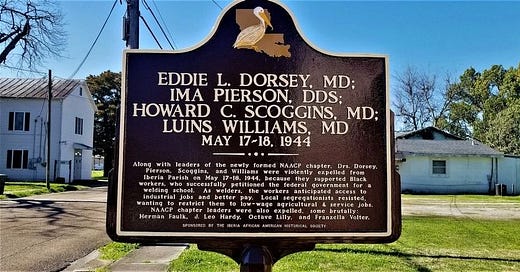In 1944, a man named J. Leo Hardy became the president of the NAACP branch office in New Iberia, Louisiana, a small town west of New Orleans widely known for growing sugar — extraordinarily brutal work. The sheriff of New Iberia Parish was a man named Gilbert Ozenne, who personified the fears of well-to-do local whites over a Black population that demanded civil and economic rights. Ozenne claimed that NAACP members were stockpiling weapons and preparing for race war; he even told the FBI this story.
Hardy was more confrontational that his predecessor. He advocated for fair and equal elections. He also advocated for a Blacks-only welding school – part of a federal wartime job training program – and tried to move the school to a Black neighborhood in order to prevent people attending the program from feeling harassed and threatened.
Ozenne was not having it. He sent deputies to pick Hardy up and bring him to the sheriff’s office. He told Hardy to leave town by 10:00 A.M. the next morning. The next day came and Hardy did not comply.
That evening a black, unmarked car with four deputies pulled up. They took him to a jail cell and, along with the sheriff himself, pummeled Hardy with fists and boots. Then, they put him into their car and drove him outside of the town’s limits, leaving him on the side of the road, bloody.
The next day, deputies kidnapped three more Black men, two of them physicians. They were all beaten, pistol-whipped, and dumped on the side of the road. (Ultimately four physicians and four civil rights leaders were “expelled” in this way.)
One of those deputies was a man named Gus “Killer” Walker. You can guess what he was like. Herbert Hoover sent FBI agents to investigate the vigilante violence, but nothing came of it. The agents’ reports attempted to be impartial, arguing that one of the men who had been assaulted was “a constant source of trouble.” They concluded that while Hardy and the other men “may have suffered mishandling at the hands of law enforcement officials,” there was not enough evidence to substantiate the “allegations.” Ozenne became the vice-president of the Louisiana Sheriffs’ Association. Killer Walker remained in his employ.
On January 7, Memphis police officers, members of a special “undercover” unit called SCORPION (Street Crimes Operation to Restore Peace in Our Neighborhoods) pulled over Tyre Nichols. They pepper-sprayed and beat him until he died.
Memphis has disbanded the SCORPION units. But why did they form them in the first place? The idea that law enforcement needs special jump-out units, small patrols with less oversight so that they can be more violent, is one of the oldest ideas in policing. Vigilance committees assembled in the cover of darkness with the express goal of “taking care” of people they thought needed taking care of. Killer Walker acted on orders from his boss, taking men by surprise and beating them to show dominance. Detroit had the STRESS unit. Los Angeles had CRASH. New York had the Street Crimes Unit.
The idea of extra-judicial, extra-violent, unaccountable beat-down units is not a novel one. Arguably, these special tactical groups are the purest form of American policing. Killer Walker was not an aberration. He was what the elite, educated people wanted in their law enforcement – someone to do the dirty work for them.



